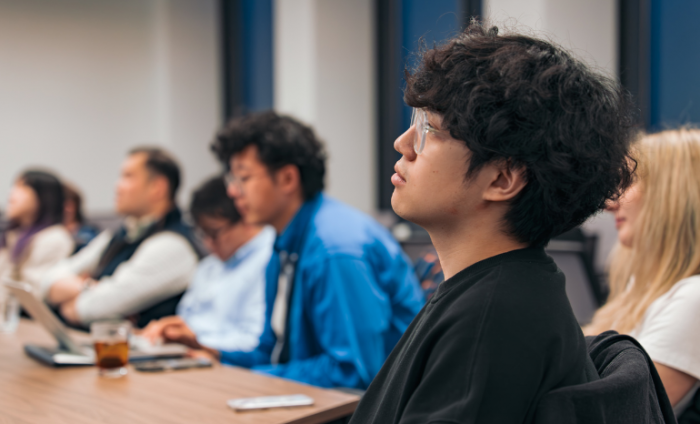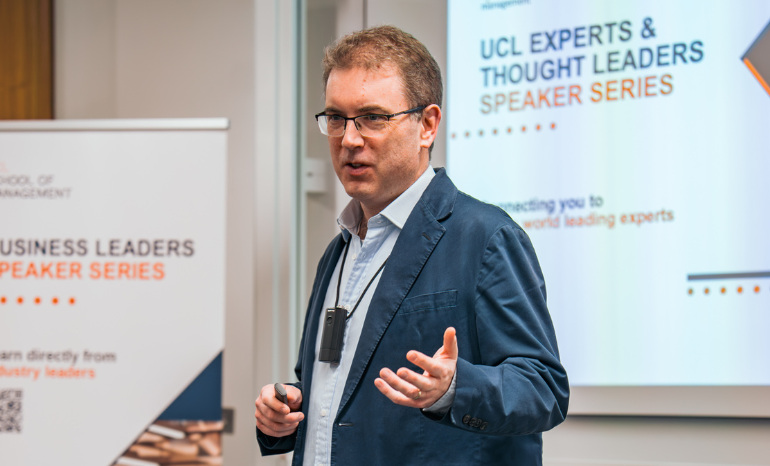
UCL School of Management officially launched its brand-new Speaker Series earlier this year. Inviting speakers from a range of industries and backgrounds to showcase their experiences and skillsets in a variety of formats, the Speaker Series is designed to welcome authentic experiences, expertise and stories and share them with the wider UCL community.
For the month of March, we invited two academics from University College London and two co-founders of a Generative AI tool called ‘SideKick’, to Canary Wharf to showcase their experience and knowledge of artificial intelligence and the evolution of the Chinese economy.
March topics included:
- Transforming Health Care With Artificial Intelligence
- Generative AI Tool ‘Sidekick’
- Journey Through China – The Past In The Present
Pearse Keane, Professor, UCL
For our first UCL Experts & Thought Leader Speaker Series of the month, the UCL community heard from Pearse Keane, Professor of Medical Innovation at University College London. During the event, Pearse explored the development of AI over time and the ethics and application of AI within the medical field, highlighting both the risks and benefits involved when integrating AI into medical practices.
Highlighting the progression of AI over the years, the first AI prototype was launched in 1956 and, 24 years later, it became capable of reproducing human decision-making. In the present day, AI has evolved to provide image recognition, translation, speech recognition and generation and most famously, ChatGPT. Well, what if it did more? Artifical intelligence has helped to develop neural networks, identifying skin cancer from images, aiding medical profressionals with detecting diabetic terinopathy in rentinal fundus photographs.
In 2023, there was a study on the partial widespread adoption of artificial intelligence in America, with over 10,000 CPT claims from practices that have had an AI device aid with assessing coronary artery disease and diagnosing retinopathy. Unfortunately, there were many limitations with the integration of AI in the medical society, mainly due to availability in high-income areas only and for those living in metropolitan areas. In 2018, the market became more flooded with the prospect of AI accelerating diagnoses and therefore giving doctors more time to find cures and treatments for eye conditions and diseases.
Recognising the constraints in medicine, AI programmes such as ‘Sora’ have been created to aid medical professionals. Sora is a Large Language Learning model that has the sole purpose of aiding medical professionals and, in synergy, their clients. In the back end, Sora aids with translating complex medical terminology into a clear and accessible way for the patient to understand their condition(s), procedure(s), leading to a higher adherence rate for post-healthcare practices. Additionally, it has been designed to aid doctors and surgeons with improving consulation practices and with medical training through realistic simulations and generated video content, allowing them to practice and refine their techniques in a safe, controlled environment.

Louis Georgiou & Kenny Skelton, Founders, Sidekick
Furthering our discussions on artificial intelligence, we brought back two special guests to present as part of the New Technologies & Innovation Speaker Series: Louis Georgiou, VP of Engineering at Coregraph (WPP), and Kenny Skelton, Lead of AI Enablement at Choreograph (WPP).
Using a comedic and down-to-earth style approach, Louis and Kenny outlined the mission they set out for themselves: create an Generative AI tool that will help their workplace with mundane tasks to allow them to focus on what really matters. They began as acquaintances working at EssenceMediacom (WPP), and one day discovered their mutual interest in AI. This lead to a weekend away, where they began their journey brainstorming processes that would achieve the biggest impact for their workforce.
While Kenny had no background in coding, Louis had only coded a few times 20 years ago but, as both were commited to making a difference, they researched, implemented and used other AI programmes to assist their journey. This resulted in Kenny becoming proficient in Prompt Engineering, Louis relearning coding with AI and the successful launch of ‘Sidekick’, which has over 12,000 users.
Louis and Kenny also shared their approach, stating that “adopting Generative AI is not trivial. It is organisational change.” They are aware that not everyone appreciates the unknown and being forced to adapt. yet over time, as Sidekick became more popular, people started to see the benefits and staff became more motivated to use it. Why was there such a successful adoption? Kenny and Louis focused on people and the problem first, making their tool collaborative, hearing the issues people faced day to day and ensured Sidekick was iterative and feedback driven change.
With an outlook for the business, this tool would increase revenue, organisational efficiency, decrease costs and maintain a competitive advantage through new products and service offerings. Both speakers addressed their surprise as more colleagues are developing their own prompts through sidekick to help others. Kenny and Louis conclude the evening through inspiring the attendees to get started, learn to prompt, be a tinkerer using other AI platforms, follow AI patterns and trends and blend AI literacy with domain expertise.
Maurizio Marinelli, Professor, UCL
Concluding the monthly series, we invited Maurizio Marinelli, UCL Professor of China and Global Propserity, to share his talk titled, ‘Journey Through China – The Past in the Present’. During this event, Maurizio explored the ideology of historical practices affecting and continue to be “an active force shaping the present” economy. Maurizio first began to discuss the core cultural foundations of Buddhism, Daoism and Confucianism that continue to define China’s governance, economy and society, before exploring the constancy of change.
“To understand China today, we must recognise continuity within transformation,” Maurizio adds “change is constant, but history is always present - offering both lessons and a lens for understanding the future.” The Great Wall of China is a prime example of the historical transformation into today’s society. From the Warring States Period (445 BC) to the Ming Dynasty (1644 AD), the walls were a constant reminder to society of the inhumane acts of cruelty and destruction, with over 1 million lives lost attempting to build the wall which stood at 27,000km. In comparision to today, the walls have transformed into a tourist hot-spot, representing the new national identity of China and it continues to stand as a positive symbol of Chinese Civilisation.
Since the late 1900s, the Great Wall has been classified as a symbol of international success, inspiring a Sino-French joint venture into China’s wine industry, the development of Great Wall Motors (electric cars), inspiring artists to use features in their own work, as well as becoming a romance destination.
In 1983, Serbian and German performance figures Abramovic and Ulay journeyed alone on the Great Wall to reconnect in the centre, tying the knot in marriage. In 1993, another icon - Peng Wang - became prominent during this period, where he held a solo art exhibit in Beijing and sealed the entire entrance to the gallery with bricks to form a wall. The barrier challenged conventional notions of art presentation and viewer interaction, turning the act of obstruction into the artwork itself.
Keep up to date with our latest events: